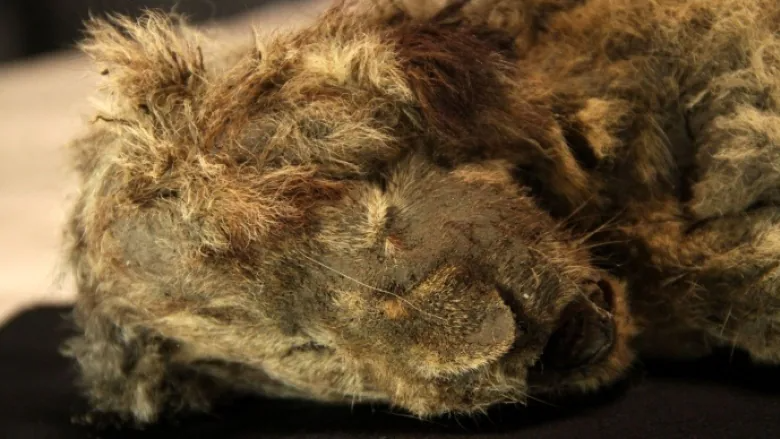Perfectly preserved cave lion cub found in Siberian permafrost

‘Sparta’ was probably 1 or 2 months old when she died 28,000 years ago
Scientists have unveiled an extraordinary find — a lion cub found in the Arctic that may be the best preserved Ice Age animal ever found.
The female cub, nicknamed Sparta, was found by a local resident named Boris Berezhnev in 2018 along Russia’s Semyuelyakh River. Berezhnev had been searching for mammoth tusks, which he had a licence to collect.
“Sparta is probably the best preserved Ice Age animal ever found, and is more or less undamaged, apart from the fur being a bit ruffled,” said Love Dalén, co-author of a new study on the find, in a news release from Stockholm University Friday. “She even had the whiskers preserved.”
Sparta, estimated to have died 28,000 years ago, was one of two lion cubs described in the study, published this week in the journal Quarternary.
The other was a male cub found by Berezhnev in 2017, just 15 metres from Sparta. At first, the researchers who recovered the cubs in Siberian permafrost thought they were siblings, but the male cub, named Boris, turned out to be much older — having died 43,000 years ago, radiocarbon dating showed.
“Boris is a bit more damaged, but still pretty good,” said Dalén, professor of evolutionary genetics at the Centre for Palaeogenetics in Stockholm.
This CAVE LION cub is arguably the best preserved #iceage animal ever found!
It’s name is Sparta.
In a paper published today with colleagues from 🇷🇺 🇯🇵 & 🇫🇷, we use DNA & 14C to show that it’s a female cub that died c 28,000 years ago.
Read more here:https://t.co/Vc2VI7VFfJ pic.twitter.com/NkXTFCvsyB
— Centre for Palaeogenetics (@CpgSthlm) August 4, 2021
The researchers estimated based on the development of the cubs’ teeth that they were both between one and two months old when they died. But they were small compared to African lion cubs with a similar level of tooth development, suggesting their teeth developed faster.
“This may be due to the short periods of warm weather [and] harsher winters in the northern latitudes, meaning cubs had to develop faster and be able to eat meat at a younger age,” the researchers wrote.
Fur colour adapted for snow-covered landscape
Sparta’s fur was greyish to light brown and Boris’s was greyish yellow, without the spots that African lion cubs have. The researchers suggested the light colour was adapted for snow-covered landscapes. They also had a thick undercoat that African lion cubs don’t have, which appeared to be adapted to a cold climate.
Their preservation suggested they must have been buried quickly, possibly in a mudslide, Dalén suggested.
The study was led by Gennady Boeskorov from the Diamond and Precious Metals Geology Institute at the Siberian Branch of the Russian Academy of Sciences, and included other researchers from Russia, France, Sweden, the U.K. and Japan.
During the last Ice Age, cave lions were a common predator throughout northern Eurasia and North America, including Canada. In fact, the first cave lion genome came from a bone from Yukon. The species went extinct about 14,000 years ago.
Related stories from around the North:
Canada: Seabirds & their vulnerability to a warming climate: Q&A with researcher Emily Choy, Eye on the Arctic
Russia: Oral histories unlock impact of climate change on nomadic life in Arctic Russia, says study, Eye on the Arctic
Sweden: Sweden to lead major Arctic expedition, Radio Sweden
United States: Climate change is worsening water scarcity in rural Alaska says study, Eye on the Arctic



